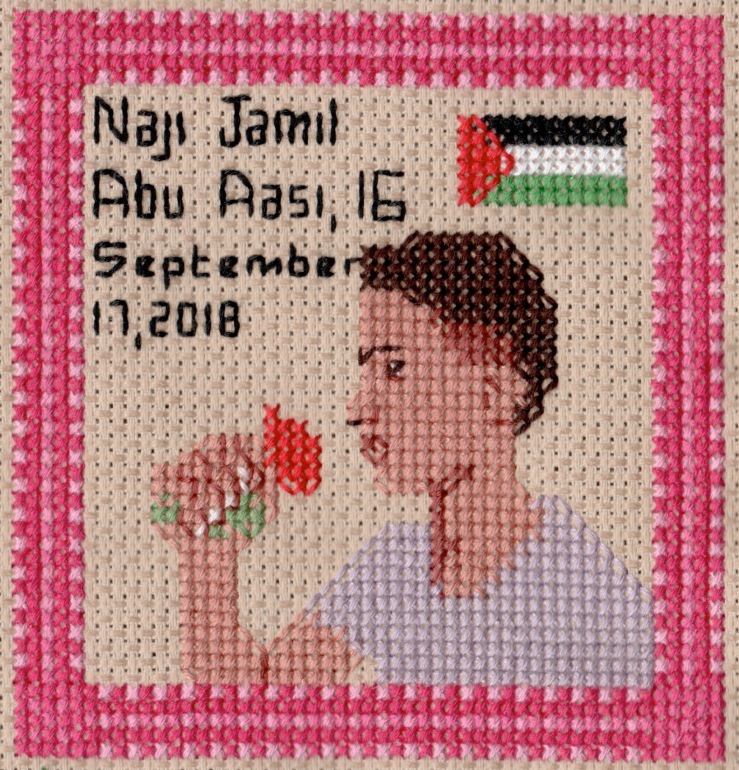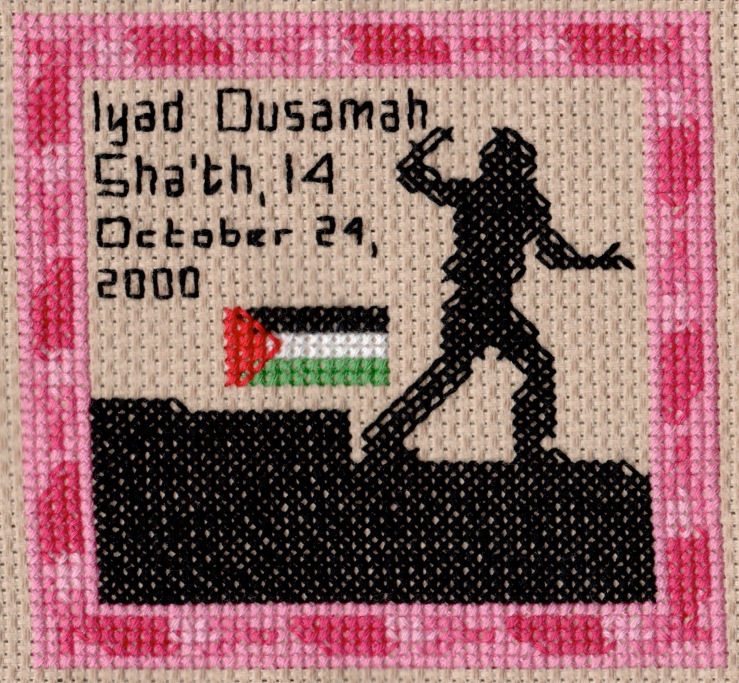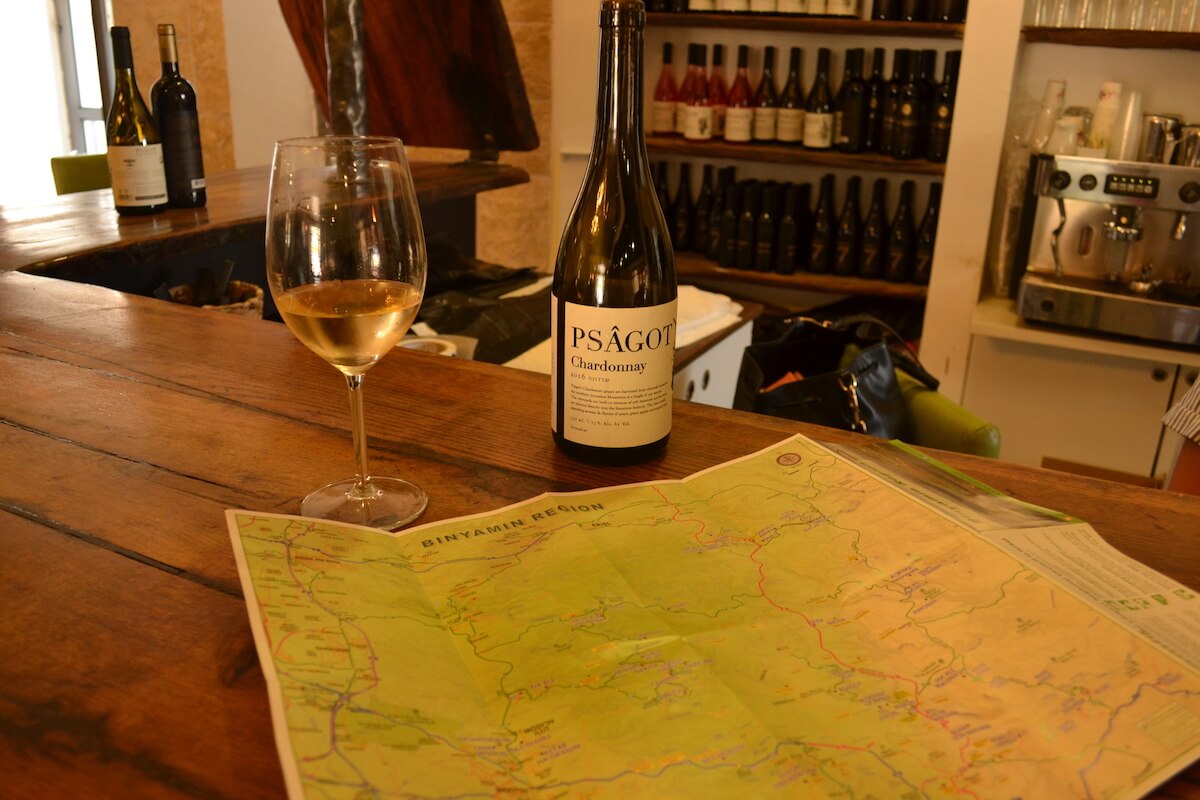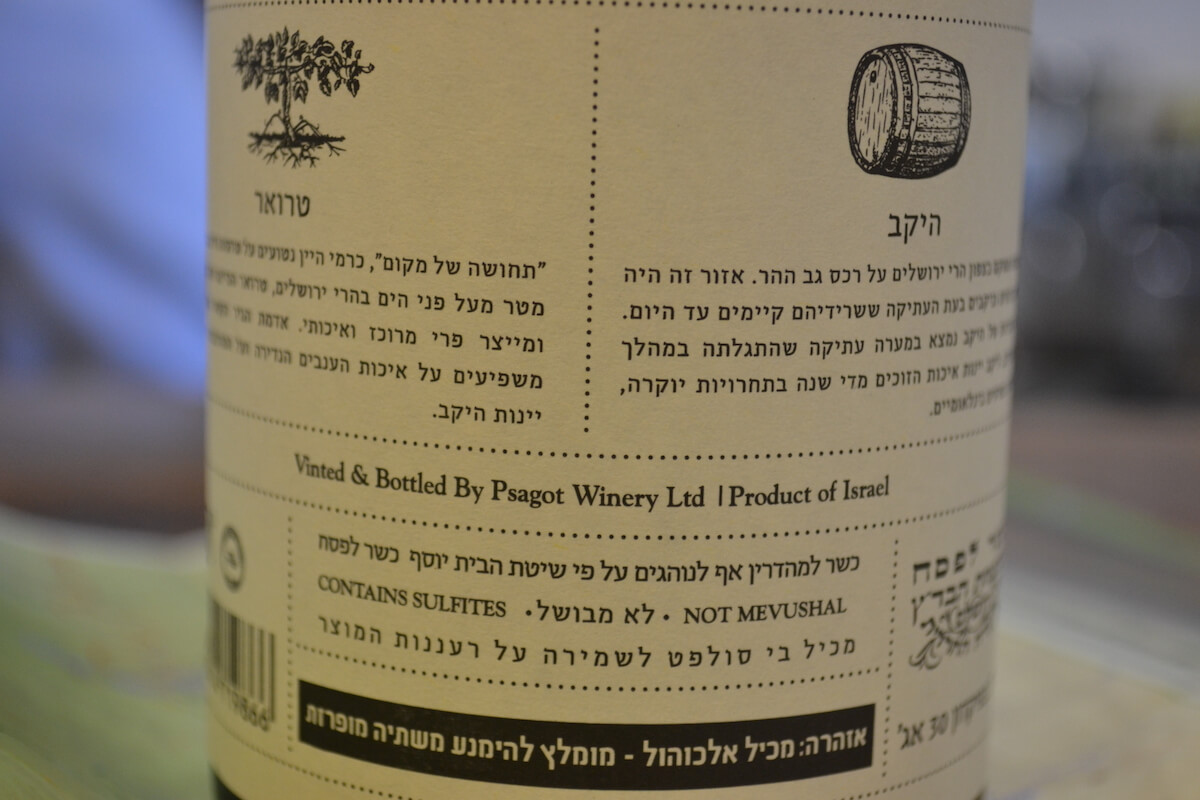Patterns of Occupied Palestine: Part 1 of Uncountable
There is no one poster child who embodies the struggle of the Palestinian people living in the shadow of Israeli settlers and military occupation. Every Palestinian child, woman, and man will tell you intricate stories of what life and death is like under the perennial burden of occupation, and what that means for the land beneath their feet, their usurped rivers, their beloved farmers and the artisans, etc.
Aisha Lulu, Amal Mustafa al-Taramsi, Haitham Ismael Saada, Amin Mansour Abu Moammar, Ahmad Ghazal, Izzedin Bani Gharra, Malak Shaker Abu Shouqa, Qutayba Ziad Zahran, Naji Jamil Abu ‘Aasi, Iyad Ousamah Sha’th, Bushra al-Taweel and Yousef Abu Sbeikha al-Boheiri are just twelve of the hundreds of thousands of Palestinians who have either been displaced, killed in cold blood by Israeli occupation forces, arrested, injured physically and psychologically, or have died indirectly by the regime’s sadistic design of collective punishment.
Each pattern of occupied Palestine tells its own story. As part of a lifelong project, I will be embroidering images of hundreds of Palestinians, deceased and living. Each of the embroidered portraits to come has a border inspired by Tatreez — a traditional Palestinian embroidery-style, and by the occupied territories’ natural, threatened landscape. Each bordered portrait is also a statement against the ugly and violent apartheid border wall.
Below are the first twelve portraits of occupation in this open-ended series:
 Border pattern includes the hairy pink flax flower
Border pattern includes the hairy pink flax flower“My heart broke every day my daughter was away… Why does Israel treat us like this? We are not affiliated to any political faction, we are just normal people,” says Muna, whose 5-year-old daughter Aisha Lulu of the Bureij Refugee Camp in the central Gaza Strip was one of the latest casualties of the Israeli occupation. Diagnosed with brain cancer in April, Aisha died on May 17 in a Gaza hospital. Prior to this, she spent a month alone in a hospital bed in Jerusalem, crying for her family, who were denied permits by the Israeli military to accompany her.

 Border pattern includes the endangered Palestinian mountain gazelle
Border pattern includes the endangered Palestinian mountain gazelleHis father, Ismail, 43, a construction worker in Kiryat Gat, looks as though he has not yet absorbed what happened. A crooked smile occasionally crosses his lips as he recounts the events of his Black Friday.” Ismail’s son, 14-year-old Haitham Saada was hit by two Israeli bullets on February 5, 2016. The IDF accused him of getting ready to throw a Molotov cocktail at the soldiers, and so they fired and killed him.



 Border pattern includes the Palestinian sunbird
Border pattern includes the Palestinian sunbird Border pattern includes olives
Border pattern includes olives
 Border pattern includes the Dead Sea which has been “shrinking rapidly due to Israel’s diversion of the head waters of the Jordan River.”
Border pattern includes the Dead Sea which has been “shrinking rapidly due to Israel’s diversion of the head waters of the Jordan River.”
 Border pattern includes olive trees. “Since 1967 some 800,000 olive trees have been uprooted by Israeli forces and settlers in the occupied West Bank alone.”
Border pattern includes olive trees. “Since 1967 some 800,000 olive trees have been uprooted by Israeli forces and settlers in the occupied West Bank alone.”Part 2 follows…
I would like to thank The Electronic Intifada, Defense for Children International, Addameer, Israel-Palestine Timeline and B’tselem for providing valuable material for this project.
----------------------------------------------------------
August 5, 2019
Patterns of Occupied Palestine: Part 2 of Uncountable:
What do Shahed Amer al-Bayoumi, Abdel-Raouf Salha, Arafat Jaradat, Ayoub Asaleya, Mohammed Suleiman, Sawsan Ali Dawud Mansour, Mohammad H., Isma’il Muslem Hamad Abu Bteihan, Ala Ziad Abu ‘Aasi, Fadi al-Darbi, Atef al-Maqousi, Jaber Ibrahim Abu Hweige,Fadiyah Jaber Abu Hweigeand MuhammadJaber Abu Hweigehave
in common? They are Palestinians between the ages of 9 and 69 who have
been severely injured, imprisoned, or killed by Israeli occupation
forces since 1992.
The first segment of this series, Patterns of Occupied Palestine:Part 1 of Uncountable, included a portrait of 18-month-old
Malak Shaker Abu Shouqa. She was one of 13 people who were killed on
July 31, 2014 when an Israeli F-16 warplane struck their homes. Four of
the people killed that day included members of the al-Bayoumi family.

This segment, Part 2, includes 9-year-old, Shahed Amer al-Bayoumi, who survived that attack but was badly injured. According to the
multimedia web documentary Obliterated Families, “She now shivers all
the time. She was in a coma for 38 days… initially she could not
recognize her family. She cannot hold a pen to write, so sometimes her
cousin sits with her at the school to help her write.” Shahed lost her
cousin Hassan, and her three sisters Abeer, Aseel, and Hadil in the attack.

13-year-old Abdel-Raouf Salha,was
the first Palestinian child to be killed by occupation forces this
year. Abdel was injured while participating in the Great March of Return
protests on January 11 in the northern Gaza Strip when he was struck in
the head by an Israeli-fired tear gas canister causing severe brain
injury. He died two days later in a hospital in Gaza City.
According to Ayed Abu Eqtaish, the Accountability Program Director for Defense for Children International – Palestine (DCIP), “Crowd control weapons such as tear gas canisters can become lethal weapons when fired at children, especially if the point of impact is on a child’s
head or torso.” DCIP also said that “a high proportion of the Gaza
Strip fatalities, 45, were killed by Israeli forces since the start of
Great March of Return protests on March 30, 2018, often in the context
of protests or related activities.”

Suspected of throwing stones and a
Molotov cocktail at occupation forces, 33-year-old Arafat Jaradat from
the occupied West Bank was arrested on February 18, 2013 and locked up
in Israel’s Megiddo prison,
where he died five days later after being interrogated by the security
agency Shin Bet. On February 24, the Palestinians rights group Al-Haq
tweeted saying that the “autopsy of #ArafatJaradat confirmed that he
didn’t die of heart attack. Body displayed multiple signs of beating.”
He was tortured. According to The Electronic Intifada (EI), “Israel has failed to launch a single criminal investigation for torture despite more than 1,000 complaints by victims since 2001.”
Arafat had two children, Yara and Mohammad.
His wife Dalal was expecting their third child at the time of his
death. According to the prisoner solidarity network Samidoun, she gave
birth to a boy on June 30and named him Arafat, “after his martyred father.”

12-year-old Ayoub Asaleya was
playing with his cousins when he was killed in an Israeli airstrike in
Jabalia refugee camp on March 11, 2012, as cross-border fighting between
the Israeli military and Palestinian militants raged on for a third
day. Adel Essi,63, was killed by shrapnel from another missile as he was guarding an orchard. According to the New York Times,
the attacks had begun “when Israeli air-to-ground missiles killed the
leader of the Popular Resistance Committees, Zuhair al-Qissi, and his
assistant in Gaza.” The prime minister of Israel, Benjamin Netanyahu boasted,
saying, “My instructions are to strike at anyone planning to harm us…
The combination of offensive capabilities, defensive capabilities and
civilian resilience is a winning combination, and we have it.”

Mohammad Suleiman, was arrested on April 18, 2011. He
is 34-years old and suffers from thalassemia and chronic anemia for
which he requires daily medical care, including frequent blood
transfusions. As a result of the transfusions his blood contains high
levels of iron, causing a perpetual weakening of his heart muscle for
which he has had to undergo a daily routine of intravenously injecting a
medication called Desferal for 8 to 10 hours to cleanse his body of
some of the excess iron. Since his arrest and subsequent medical
neglect, his health has deteriorated rapidly; tests confirm that he has
an enlarged heart and liver.
According to the prisoner support group
Addameer, Mohammad is currently in administrative detention, “a
procedure that allows the Israeli military to hold detainees
indefinitely on secret evidence without charging them or allowing them
to stand trial… The entire family, except for his 20-year-old sister, is
currently forbidden from visiting Mohammed.” In early October of ’11
Mohammed’s wife gave birth to Suleiman, their first child.

In a new wave of unrest that broke out between
Occupation forces and Palestinians in October 2015, 28 Israelis and more
than 200 Palestinians were killed, including the latest victim,
19-year-old Sawsan Ali Dawud Mansour, who was gunned down near the Ras
Biddu checkpoint north of Jerusalem on May 23, 2016. According to Ma’an
News Agency (MNA), an Israeli spokesperson claimed that a “female
terrorist” allegedly attempted to stab a soldier, when “another officer
immediately fired gunshots at the Palestinian teen and ‘neutralized’
her.” No Israelis were reported injured in the incident.

“I used to play soccer and ride my
bike but now my life has completely changed… My message to Israel is
that I was participating in a peaceful march and they shot me in the leg
and now I don’t have a leg.” Those are the words of 13-year-old Mohammad H., who was severely injured on June 29, 2018.
According to DCIP, Israeli forces shot him “at around 6:30 p.m., near
Jabalia refugee camp in the northern Gaza Strip… He marched toward the
fence with a group of other protesters. Mohammad was unarmed and making a
‘victory’ sign with his fingers. Israeli forces fired multiple rounds
at the group and one bullet struck Mohammad’s leg.”
In 2018, DCIP “documented 18
cases of Palestinian children who suffered permanent disability as a
result of injuries sustained in the context of Great March of Return
protests.”
The patterns of Israeli atrocities and collective
punishment carried out on the Palestinians, their families and
neighbors, their homes and infrastructure can clearly be seen in the
summer of 2014 and the 51-day onslaught of
explosives that rained down on the Gaza Strip. The explosive force that
killed more than 520 children, including Malak Abu Shouqa and Shahed
al-Bayoumi’s three sisters and cousin and left her constantly shivering with fear was “roughly equivalent to that of the Hiroshima atomic bomb,” according to EI.

Just four days before the August 26 ceasefire agreement that ended the assault, Isma’il Muslem Hamad Abu Bteihan, a 69-year-old resident of a-Zawaydah, Deir al-Balah district was killed in
a missile attack. According to B’Tselem, he was “killed while sitting
under the shade of a tree opposite his home. Four hours later his home
was bombarded and completely destroyed.”

In addition to Malak Shaker Abu Shouqa, Part 1 of Patterns of Occupied Palestine featured
16-year-old Naji Jamil Abu ‘Aasi, who was killed on the 17th of
September, 2018 by an Israeli missile along with his cousin. According
to Al Mezan Center for Human Rights, “At 12:50 am the next day…
Palestinian Red Crescent Society medical teams found the bodies of
two civilian-dressed persons. Both had shrapnel injuries on various
parts of their bodies and one of them was torn to pieces. The two bodies
were taken to Nasser Hospital in Khan Younis, where they were
identified as Naji Abu ‘Asi, 16, and Alaa’ Abu ‘Asi, 19 [featured here, in part 2]—both residents of Al-Zanna area in Bani Sohaila town in eastern Khan Younis.”

A 30-year-old Palestinian resident of Jenin named Fadi al-Darbidied on October 14, 2015 after suffering “medical negligence by the Israeli Prison Service.” Fadi had been detained by
Israeli forces back in 2006 and sentenced to 16 years in jail. The
Palestinian Prisoner’s Society said in a statement “that he suffered
bleeding in his abdomen two years ago, but was left in solitary
confinement, without medical treatment.”

37-year-old Atef al-Maqousi from Jabalia refugee camp
in northern Gaza died on November 8, 2107, after living in a
quadriplegic state for 25 years. According to the media center IMEMC, he
was shot in
the spine by Israeli soldiers in 1992 and as a result suffered ongoing
infections and other complications that eventually lead to his death.
“At 11:27 am on 27 December 2008, Gaza was bombarded by
Israeli warplanes. Instead of the anticipated school bell, the children
heard the horrifying sound of bombs.” That’s when Operation Cast Lead
began. According to the EI “Israel used its air force, navy, infantry
and artillery against a population that already had a long experience of being under military occupation and, more recently, under siege.”

“I lived with my parents and brothers and sisters in the Tufah neighborhood in Gaza City. Our house is between the police building and the al-Mahata mosque. On Saturday, 27.12. 08, while I was at work, one of my neighbors called me and told me to come home quickly.
I got home and was shocked by what I saw. The house had been hit by an explosion and was a pile of rubble. Where the house had been there was a big hole. There were dozens of people trying to get my family out of the ruins, but they only managed to get some of them out alive.My father, Jaber Abu Hweij, 52, my sister, Fadia, 22, and my brother Muhammad, 18, were killed in the bombing. Many other family members were injured.
The neighbors told me the house had been hit three times, one right after the other. Some of my family was hurt in the first strike and while others tried to help them, the house was hit again and others were injured. It happened so quickly there was no time to flee.
I keep seeing my sister Fadia in my mind. She was the last one I saw that morning when I left for work. She is the one who woke me for morning prayers and to go to work. Her voice still echoes in my ears….
Our family has fallen apart. Some [have] been killed and others are hospitalized. We lost our home and all our possessions: all our mementos, our dreams, our stories, our furniture, everything is under the ruins. The important thing now is for me to take care of my family that is still alive. I am particularly taking care of my brother Ahmad, who is still in intensive care.”
Please go here to see Patterns of Occupied Palestine: Part 1 of Uncountable. Part 3 will follow next month . . .






![Nelson Mandela's grandson slams 'Israeli apartheid' Mandela sketched out a damning picture of the discrimination experienced by the Palestinian people [File: Leon Neal/Getty Images]](https://www.aljazeera.com/mritems/imagecache/mbdxxlarge/mritems/Images/2019/7/7/5d559d588afa40d697c20d16dcf52b4f_18.jpg)




